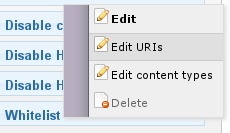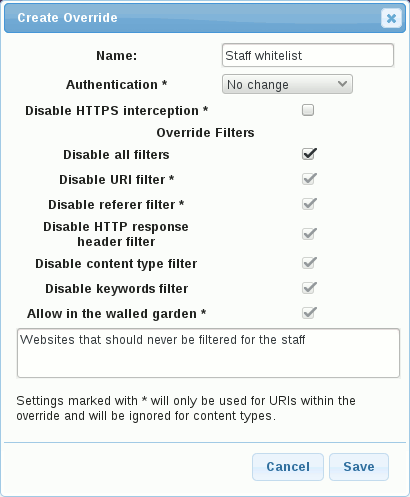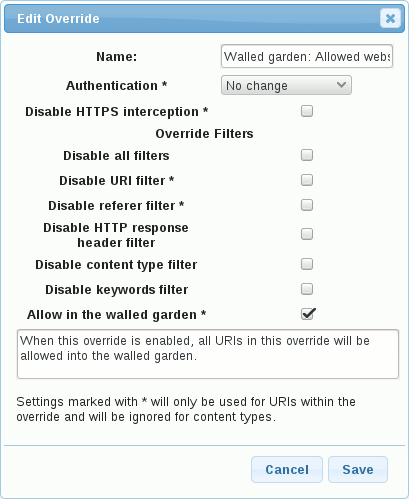Whitelisting websites and their content
Whilst we endeavor to make our filters as accurate as possible, no filtering system is perfect and sometimes you want to completely disable the filters for certain websites that you know are safe so as to avoid the inconvenience of it being inadvertently blocked. For example, educational sites that are often used by your teachers and students, which have been reviewed and deemed safe enough for you to turn off the filtering. This can be further complicated when objects from a different website, such as Youtube videos, photos, etc., are embedded in your "safe" site.
This is the second in a regular series of "how to" articles to provide step by step instructions on how to do some common things with Web Gateway and UTM. By following through these examples, you can gain an understanding of how to configure your system to work exactly how you need it to.
Whitelisting globally
By default Web Gateway and UTM systems have an override called Whitelisted websites that is applied to the Everyone group. If you would like to disable the filters for a certain website, irrespective of who the user is, this is where to set it up.
- Go to the Override Editor in the Web tab. You'll see all of the overrides listed on the left hand side - right click the Whitelisted websites override and select Edit URIs. A box will pop up showing you any web addresses that you have previously added to that override. In this example, we'll disable the filtering on example.com.
- Click the Add URI link at the bottom of the list of addresses and a second popup box will appear for you to enter the web address in. Enter example.com into the Host field and click Ok.
- Finally, hit the Save button to save the changes to the override.
Whitelisting for a specific user group
As we've seen above, the Whitelisted websites override applies to everyone by default. However, you can create overrides that are only applied to specific user groups. In this case, we're going to disable filtering on example.com for anyone in the Staff group.
- Go to the Override Editor in the Web tab. Click the Create button in the toolbox and enter a name for the override, such as Staff whitelist. Tick the Disable all filters checkbox and leave all of the other settings the same. Its a good idea to enter a comment to explain the purpose of the override, for your future reference. Once you're done, hit Save and the new override will appear in the list on the left.
- Right click the new override and select Edit URIs. A box will pop up what would show you any web addresses that you have previously added to that override, but since this is a new override that list will be empty.
- Click the Add URI link and a second popup box will appear for you to enter the web address in. Enter example.com into the Host field and click Ok.
- Hit the Save button to save the changes to the override.
- We've created the new override and told it to disable filtering for example.com, but the system doesn't yet know when to use it. Go to Overrides & Walled Garden and select the Staff group. Click the Add Override button, select your new override from the pop up box and hit Ok. Now just click the Save button.
Embedded objects
So far we've turned off filtering for all objects hosted by example.com, which is fine for self contained websites. However, some websites use objects such as photos, video, javascript, etc. from third party websites. This is particularly a problem if you have blocked access to Youtube by enabling the Streaming Media filter category, but you still want the embedded Youtube videos on a particular educational site to be accessible.
When you added the URI, you may have noticed a couple of checkboxes at the bottom of the dialogue box:
- Apply to Embedded Objects - ticking this box will cause the override to also apply to any objects directly embedded in a page on example.com.
- Apply to Embedded Youtube Videos - this is similar to the above option, but enables an adaptive filtering system that also applies the override to any Youtube videos that are embedded in a page on example.com.
You can go back to the Override Editor in the Web tab, right click the override, edit the URI to change these settings, and the filters will be updated instantly. Remember that you can always generate a short log search report to find out why things are being blocked, or whether the override is being correctly applied to the web requests.
Walled garden
Allowing websites in the walled garden system is very similar to completely disabling the filters and you can use the above instructions as a good starting point. Disabling all of the filters for a website will allow it to be accessed even when the walled garden is active, but you can also allow websites into the walled garden without disabling all the filtering. This is done in a very similar way - by default, URIs listed in the Walled garden: Allowed websites override can be accessed by all users in a walled garden; or you can create a new override for specific groups of users exactly as described above, but tick Allow in the walled garden instead of Disable all filters




